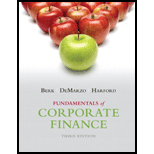
Expected return:
Expected return of the market refers to the return earned from the market over and above the risk-free  is the return that an investor must demand for inflation and the time-value of money, even when there is hardly any risk of any financial loss. Risk premium varies with the systematic risk in an investment. It is the market risk premium multiplied by the beta (ß) of a security. It is determined as the market risk premium multiplied by the beta of the security. The market risk premium is equal to the expected market return less the return earned from risk-free security.
is the return that an investor must demand for inflation and the time-value of money, even when there is hardly any risk of any financial loss. Risk premium varies with the systematic risk in an investment. It is the market risk premium multiplied by the beta (ß) of a security. It is determined as the market risk premium multiplied by the beta of the security. The market risk premium is equal to the expected market return less the return earned from risk-free security.
The expected return can be calculated using the formula given below.

Where,
 is the expected return.
is the expected return. is the risk free rate of return.
is the risk free rate of return. is the beta of the asset.
is the beta of the asset. is the expected return of the market.
is the expected return of the market.
Beta:
Beta  measures the change in percentage in the excess return of a particular security for 1% change in the excess return of a market portfolio or a benchmark portfolio. The beta
measures the change in percentage in the excess return of a particular security for 1% change in the excess return of a market portfolio or a benchmark portfolio. The beta  of a market portfolio is always 1. However, the securities may have either higher or lower betas as compared to the beta of the market portfolio. The primary reason for this difference is the sensitivity of the individual industries to the economy.
of a market portfolio is always 1. However, the securities may have either higher or lower betas as compared to the beta of the market portfolio. The primary reason for this difference is the sensitivity of the individual industries to the economy.
The beta  of a portfolio is the weighted average beta of the overall stocks in a portfolio.
of a portfolio is the weighted average beta of the overall stocks in a portfolio.
The beta  of a portfolio with three stocks, Stock E, Stock C, and Stock K can be calculated using the formula given below.
of a portfolio with three stocks, Stock E, Stock C, and Stock K can be calculated using the formula given below.

Where,
 is the beta of a portfolio.
is the beta of a portfolio. is the weight of a stock.
is the weight of a stock.
To determine:
Whether the stock must be bought.
Want to see the full answer?
Check out a sample textbook solution
Chapter 12 Solutions
Fundamentals of Corporate Finance (3rd Edition) (Pearson Series in Finance)
 Essentials Of InvestmentsFinanceISBN:9781260013924Author:Bodie, Zvi, Kane, Alex, MARCUS, Alan J.Publisher:Mcgraw-hill Education,
Essentials Of InvestmentsFinanceISBN:9781260013924Author:Bodie, Zvi, Kane, Alex, MARCUS, Alan J.Publisher:Mcgraw-hill Education,

 Foundations Of FinanceFinanceISBN:9780134897264Author:KEOWN, Arthur J., Martin, John D., PETTY, J. WilliamPublisher:Pearson,
Foundations Of FinanceFinanceISBN:9780134897264Author:KEOWN, Arthur J., Martin, John D., PETTY, J. WilliamPublisher:Pearson, Fundamentals of Financial Management (MindTap Cou...FinanceISBN:9781337395250Author:Eugene F. Brigham, Joel F. HoustonPublisher:Cengage Learning
Fundamentals of Financial Management (MindTap Cou...FinanceISBN:9781337395250Author:Eugene F. Brigham, Joel F. HoustonPublisher:Cengage Learning Corporate Finance (The Mcgraw-hill/Irwin Series i...FinanceISBN:9780077861759Author:Stephen A. Ross Franco Modigliani Professor of Financial Economics Professor, Randolph W Westerfield Robert R. Dockson Deans Chair in Bus. Admin., Jeffrey Jaffe, Bradford D Jordan ProfessorPublisher:McGraw-Hill Education
Corporate Finance (The Mcgraw-hill/Irwin Series i...FinanceISBN:9780077861759Author:Stephen A. Ross Franco Modigliani Professor of Financial Economics Professor, Randolph W Westerfield Robert R. Dockson Deans Chair in Bus. Admin., Jeffrey Jaffe, Bradford D Jordan ProfessorPublisher:McGraw-Hill Education





